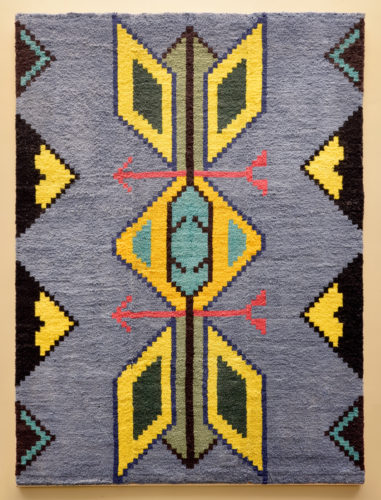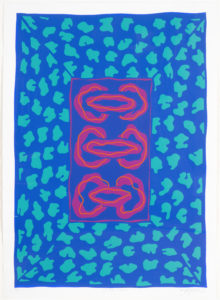
Tapestry (Tah-hah-sheena), Martha Tawiyaka, c. 1970, wool, 144″ x 60″. University of Regina President’s Art Collection; pc.1971.4. © the Estate of Martha Tawiyaka. Reproduced with the permission of Vincent Rider. Photograph by the University of Regina.
In 1967, the University of Regina received a letter from a student, noting that, “I have been impressed by the exterior architecture of all the buildings on campus. Unfortunately, however, the interior of each building… is dominated by bright white fluorescent lights and white walls. Would it not be possible to improve the situation by placing paintings or prints throughout the halls and classrooms of the University?”
Back in 1936, the University of Regina had received a donation of significant cultural importance. Norman MacKenzie’s bequest of both his art collection and the funds to build a gallery would prove to be a catalyst in the revitalisation of the Regina College. Moreover, it was a pivotal moment in establishing major cultural growth at the University of Regina, playing a part in the foundation of the School of Art, the Norman MacKenzie Art Gallery and subsequently the university’s Fine Arts programs.
With the prestigious bequest safely housed at the Norman MacKenzie Art Gallery’s class A facility, a small collection of artwork had accumulated on campus, now known as the President’s Art Collection. Works that had been collected or donated to departments such as the College of Education from as early as 1929, this collection included paintings by Nicolas de Grandmaison, August Kenderdine and Walter J. Phillips. However, campus expansions had created new spaces with only the stark lighting and bare walls described in the letter above.
“The barren walls of the Classroom Building on Regina Campus are finally bearing works of art”, declared an article that appeared in the Regina Leader Post, June 10th 1972. The new additions were a result of four years of planning by the President’s Committee on Campus Art (now the President’s Advisory Committee on Art), a steadfast group created to care for the collection. In addition, they were tasked with sourcing funds, cataloguing, advising and purchasing artworks for the University, efforts that responded to a general need to improve the campus environment. Their priority was to display works in public spaces, rather than “decoration for faculty offices or coffee rooms or lounges” (letter from Frank Nulf to Professor N. Sherlock, March 2nd, 1977), ensuring that works of art could be enjoyed by all. They determined to acquire artwork both locally and further afield in order to establish an exciting contemporary collection representing the latest artistic output. In February 1972, committee member Nancy Dillow, the Director of the Norman MacKenzie Art Gallery (1967-1979), was due to make a trip to Toronto on gallery business. She was joined by Dr. Frank Nulf, the Associate Dean of Arts and Science to view works for purchase from “Art Galleries, Artists Studios and permanent collections”. This was to be the first of several buying trips.
One of the most significant sources of purchased artwork for the President’s Art Collection was Gallery Marlborough-Godard. Representing Joe Fafard and Takao Tanabe amongst others, Mira Godard’s redbrick townhouse gallery on Hazelton Avenue became both a fixture and a pioneer in the commercial contemporary artworld in Canada. Her international relationships, namely with Marlborough Galleries in London and New York, extended her reach beyond domestic borders. This partnership became official when Gallery Marlborough-Godard (or MG as the discreet initials on the door stated), opened in 1972. With its roster of major artists and international prestige it ensured the gallery became a major contributor to Toronto’s status as the epicentre of the Canadian artworld. In Marlborough-Godard’s inaugural exhibition, Canadian luminaries hung alongside European and American greats: Kenneth Lochhead, Takao Tanabe and Jacques Hurtubise were viewed next to Josef Albers, Francis Bacon, Pablo Picasso and Jackson Pollock, fruit of the Marlborough partnership. At the time, this was considered an injection of much-needed dynamism for Toronto.
A number of the University’s works originating from Marlborough-Godard were purchased in 1974 and 1975; a golden period for the gallery. 1974 was also a significant year for the University of Regina, which became independent from the University of Saskatchewan. This active period of collecting during the transition from partnership to separation may explain why a number of similar works remain in the two university’s collections today. Works in this exhibition purchased from Gallery Marlborough-Godard include Anthony Benjamin, Jacques Hurtubise, Eugenio Tellez, Joe Tilson, Robert Motherwell, Adolph Gottlieb, R.B. Kitaj and Takao Tanabe. The strength and range of artists – from Canada, the USA, and the UK – attest to the gallery’s promotion and the University’s interest in both Canadian and international art.

O Factor, from the Roxy Bias series (5/95), Anthony Benjamin, 1972, serigraph on paper, 40” x 29”. University of Regina President’s Art Collection; pc.1974.3. © the Benjamin Estate. Photograph by the University of Regina.
Tony Urquhart was represented by Nancy Poole Studio, a gallery established in Toronto in 1971 and a neighbour of Godard’s on Hazleton Avenue. But whilst visits to Toronto resulted in the acquisition of work by important national and international artists, the University also focused sourcing efforts closer to home. Nancy Dillow stated that “though we don’t restrict ourselves to Saskatchewan artists alone, they get first priority”. Around the same time they were connecting with the Toronto galleries, trips were also made to Saskatoon to visit the studios of William Perehudoff, Dorothy Knowles, Otto Rogers and Ernest Lindner, all of which resulted in acquisitions. Three wall hangings, now on display in the Archer Library, by Bernice Runns, Marjorie Yuzicappi and Martha Tawijaka from Fort Qu’Appelle’s Standing Buffalo reserve were commissioned. An interest in indigenous practices can also be seen in the acquisition of the University’s first Inuit artwork, Paulassie Pootoogook’s Legendary Figure of Taliilajuuq (c.1971).
Additionally, Visual Arts head Jack Sures was commissioned to produce a mural for the new Classroom building in 1972. The same year, Takao Tanabe was commissioned to create a set of banners for the new Administration Humanities building, whilst he was at the Banff Centre. Both these artworks can still be viewed today, in situ.
One of the few members of the reknowned Regina Five to remain in the city into the seventies was Arthur McKay. The Five’s activities had long interweaved with the university, starting when Kenneth Lochhead was hired as the head of the new School of Art and his subsequently employment of McKay. Ronald Bloore arrived as director of the Norman MacKenzie Art Gallery in 1958, sharing a studio with Ted Godwin, and Douglas Morton was a close friend of the group. Their organisation and participation in the university’s Emma Lake Artist’s Workshops and influence as educators proved mutually beneficial. In addition to his teaching relationship with the university, McKay became an Artist-in-Residence for three years in the mid seventies. Several artworks were donated under the terms of this arrangement (two per year), and several more were purchased.
As these artworks demonstrate, the President’s Committee on Campus Art’s activities proved highly fruitful, acquiring a number of significant artworks that remain highlights of the collection today.
Find examples of artwork acquired in the 1970’s below:


